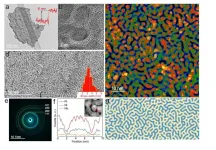(Press-News.org) Babies and toddlers exposed to television or video viewing may be more likely to exhibit atypical sensory behaviors, such as being disengaged and disinterested in activities, seeking more intense stimulation in an environment, or being overwhelmed by sensations like loud sounds or bright lights, according to data from researchers at Drexel’s College of Medicine published today in the journal JAMA Pediatrics.
According to the researchers, children exposed to greater TV viewing by their second birthday were more likely to develop atypical sensory processing behaviors, such as “sensation seeking” and “sensation avoiding,” as well as “low registration” — being less sensitive or slower to respond to stimuli, such as their name being called, by 33 months old.
Sensory processing skills reflect the body’s ability to respond efficiently and appropriately to information and stimuli received by its sensory systems, such as what the toddler hears, sees, touches, and tastes.
The team pulled 2011-2014 data on television or DVD-watching by babies and toddlers at 12- 18- and 24-months from the National Children’s Study of 1,471 children (50% male) nationwide.
Sensory processing outcomes were assessed at 33 months using the Infant/Toddler Sensory Profile (ITSP), a questionnaire completed by parents/caregivers, designed to give insights on how children process what they see, hear and smell, etc.
ITSP subscales examine children’s patterns of low registration, sensation seeking, such as excessively touching or smelling objects; sensory sensitivity, such as being overly upset or irritated by lights and noise; and sensation avoiding — actively trying to control their environment to avoid things like having their teeth brushed. Children score in “typical,” “high” or “low” groups based on how often they display various sensory-related behaviors. Scores were considered “typical” if they were within one standard deviation from the average of the ITSP norm.
Measurements of screen exposure at 12-months were based on caregiver responses to the question: “Does your child watch TV and/or DVDs? (yes/no),” and at 18- and 24- months based on the question: “Over the past 30 days, on average, how many hours per day did your child watch TV and/or DVDs?”
The findings suggest:
At 12 months, any screen exposure compared to no screen viewing was associated with a 105% greater likelihood of exhibiting “high” sensory behaviors instead of “typical” sensory behaviors related to low registration at 33 months
At 18 months, each additional hour of daily screen time was associated with 23% increased odds of exhibiting “high” sensory behaviors related to later sensation avoiding and low registration.
At 24 months, each additional hour of daily screen time was associated with a 20% increased odds of “high” sensation seeking, sensory sensitivity, and sensation avoiding at 33 months.
The researchers adjusted for age, whether the child was born prematurely, caregiver education, race/ethnicity and other factors, such as how often the child engages in play or walks with the caregiver.
The findings add to a growing list of concerning health and developmental outcomes linked to screen time in infants and toddlers, including language delay, autism spectrum disorder, behavioral issues, sleep struggles, attention problems and problem-solving delays.
“This association could have important implications for attention deficit hyperactivity disorder and autism, as atypical sensory processing is much more prevalent in these populations,” said lead author Karen Heffler, MD, an associate professor of Psychiatry in Drexel’s College of Medicine. “Repetitive behavior, such as that seen in autism spectrum disorder, is highly correlated with atypical sensory processing. Future work may determine whether early life screen time could fuel the sensory brain hyperconnectivity seen in autism spectrum disorders, such as heightened brain responses to sensory stimulation.”
Atypical sensory processing in kids with autism spectrum disorder (ASD) and ADHD manifests in a range of detrimental behaviors. In children with ASD, greater sensation seeking or sensation avoiding, heightened sensory sensitivity and low registration have been associated with irritability, hyperactivity, eating and sleeping struggles, as well as social problems. In kids with ADHD, atypical sensory processing is linked to trouble with executive function, anxiety and lower quality of life.
“Considering this link between high screen time and a growing list of developmental and behavioral problems, it may be beneficial for toddlers exhibiting these symptoms to undergo a period of screen time reduction, along with sensory processing practices delivered by occupational therapists,” said Heffler.
The American Academy of Pediatrics (AAP) discourages screen time for babies under 18-24 months. Live video chat is considered by the AAP to be okay, as there may be benefit from the interaction that takes place. AAP recommends time limitations on digital media use for children 2 to 5 years to typically no more than 1 hour per day.
“Parent training and education are key to minimizing, or hopefully even avoiding, screen time in children younger than two years,” said senior author David Bennett, PhD, a professor of Psychiatry in Drexel’s College of Medicine.”
Despite the evidence, many toddlers view screens more often. As of 2014, children age 2 and under in the United States averaged 3 hours, 3 minutes a day of screen time, up from 1 hour, 19 minutes a day in 1997, according to a 2019 research letter in JAMA Pediatrics. Some parents cite exhaustion and inability for affordable alternatives as reasons for the screen time, according to a July 2015 study in the Journal of Nutrition and Behavior.
Although the current paper looked strictly at television or DVD watching, and not media viewed on smartphones or tablets, it does provide some of the earliest data linking early-life digital media exposure with later atypical sensory processing across multiple behaviors. The authors said future research is needed to better understand the mechanisms that drive the association between early-life screen time and atypical sensory processing.
In addition to Heffler and Bennett, authors on this paper include Binod Acharya, who completed the work while at Drexel’s Dornsife School of Public Health’s Urban Health Collaborative, and Keshab Subedi from Christiana Care Health Systems.
###
END
Cedars-Sinai Cancer investigators have analyzed the cells within triple-negative breast cancer tumors before and after radiation therapy with immunotherapy, identifying three patient groups with different responses to the treatment. Their study, published in the peer-reviewed journal Cancer Cell, found that for some patients with this difficult-to-treat cancer, radiation therapy plus immunotherapy could yield the best tumor-fighting immune response prior to surgery.
“Our most important finding was identifying these three different patient groups,” said Simon Knott, PhD, co-director of the Applied Genomics Shared Resource at ...
Hydrogen energy has emerged as a promising alternative to fossil fuels, offering a clean and sustainable energy source. However, the development of low-cost and efficient catalysts for hydrogen evolution reaction remains a crucial challenge. A research team led by scientists from City University of Hong Kong (CityU) has recently developed a novel strategy to engineer stable and efficient ultrathin nanosheet catalysts by forming Turing structures with multiple nanotwin crystals. This innovative discovery paves the way for enhanced catalyst performance for green hydrogen production.
Producing hydrogen through the process of ...
An international team of researchers has found that Africa’s birds of prey are facing an extinction crisis.
The report, co-led by researchers from the School of Biology at the University of St Andrews and The Peregrine Fund, and published in the journal Nature Ecology & Evolution (4 January 2024), warns of declines among nearly 90% of 42 species examined, and suggests that more than two-thirds may qualify as globally threatened.
Led by Dr Phil Shaw from St Andrews and Dr Darcy Ogada of The Peregrine ...
After stem cell transplantation, the donated immune cells sometimes attack the patients' bodies. This is known as graft versus host disease or GvHD. Researchers at the Technical University of Munich (TUM) and the Universitätsklinikum Regensburg (UKR) have shown that GvHD is much less common when certain microbes are present in the gut. In the future, it may be possible to deliberately bring about this protective composition of the microbiome.
Stem cell transplantation can save the lives of patients suffering ...
BEIJING, Dec. 19 (Xinhua) -- A team of Chinese researchers used a novel theory to invent a new type of ultrathin optical crystal with high energy efficiency, laying the foundation for next-generation laser technology.
Prof. Wang Enge from the School of Physics, Peking University, recently told Xinhua that the Twist Boron Nitride (TBN) made by the team, with a micron-level thickness, is the thinnest optical crystal currently known in the world. Compared with traditional crystals of the same thickness, its energy efficiency is raised by 100 to 10,000 times.
Wang, also an ...
Could a Drug Prevent Hearing Loss from Loud Music and Aging?
Researchers have found a gene that links deafness to cell death in the inner ear in humans – creating new opportunities for averting hearing loss.
A person’s hearing can be damaged by loud noise, aging and even certain medications, with little recourse beyond a hearing aid or cochlear implant.
But now, UCSF scientists have achieved a breakthrough in understanding what is happening in the inner ear during hearing loss, laying the groundwork for preventing deafness.
The research, ...
DETROIT (Jan. 8, 2024) – Henry Ford Health has earned two distinguished recognitions, the HX Pinnacle of Excellence Award® and HX Guardian of Excellence Award®, both in the category of Consumer Experience and granted by Press Ganey, a leading organization focused on patient experience measurement and healthcare performance improvement. These awards reflect Henry Ford Health's unwavering commitment to providing an exceptional care experience for each of its patients and their families.
"We are immensely proud to receive the Pinnacle of Excellence and Guardian of Excellence Awards from Press Ganey,” said Bob Riney, President and ...
Mycelial fibers, the fibrous cells found in fruiting mushroom bodies, have gained momentum as a sustainable material for making leather and packaging owing to their excellent formability. Recently, a team of researchers from Shinshu University, Japan, has found a simple way of obtaining mycelial fibers, called “mycelial pulp,” from fruiting mushroom bodies and bleaching them using sunlight while keeping their mycelial structures intact.
Every year, humans generate millions of tons of waste, and almost 38% of that waste ends up in a landfill. A significant portion of it is made up of plastic or petroleum-based ...
School connectedness – the degree to which students feel part of their school community – influences more than grades. For Black students, it’s a protective factor against depression and aggressive behavior later in life, according to a Rutgers University-New Brunswick study.
“Our data provide fairly strong evidence for the idea that the experiences Black adolescents have in their school impacts their long-term mental health,” said Adrian Gale, an assistant professor in the Rutgers School ...
Atrial fibrillation (AF) is a major global health concern impacting millions and causing symptoms like palpitations, dyspnea, fatigue, dizziness, and chest discomfort. Furthermore, these symptoms reduce patients’ quality of life and lead to increased mortality and morbidity. The medical community agrees that epicardial adipose tissue (EAT), chronic inflammation, imbalances in the autonomic nervous system (ANS), stretch-induced fibrosis, and genetic alterations are the main factors that influence AF pathogenesis. Despite extensive research efforts focused on uncovering the underlying mechanisms ...


